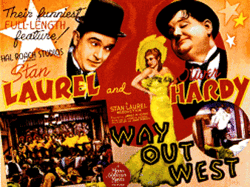Way Out West (1937 film)
| Way Out West | |
|---|---|
|
theatrical release poster | |
| Directed by | James W. Horne |
| Produced by |
Stan Laurel Hal Roach |
| Written by |
Contributing (uncredited): Stan Laurel James W. Horne Arthur V. Jones |
| Screenplay by |
Charley Rogers Felix Adler James Parrott |
| Story by |
Jack Jevne Charley Rogers |
| Starring |
Stan Laurel Oliver Hardy |
| Music by | Marvin Hatley |
| Cinematography |
Art Lloyd Walter Lundin |
| Edited by | Bert Jordan |
Production company | |
| Distributed by | Metro-Goldwyn-Mayer |
Release dates |
|
Running time | 65 minutes |
| Country | United States |
| Language | English |
Way Out West is a Laurel and Hardy comedy film released in 1937. It was directed by James W. Horne, produced by Stan Laurel and distributed by Metro-Goldwyn-Mayer.[1] This was the second picture for which Stan Laurel was credited as producer – the first was 1936's Our Relations. Laurel served in that uncredited capacity for the duo's entire career.
Plot
Stan and Oliver, after consorting with Seymore "Sy" Roberts, an old prospector, have been entrusted to deliver the deed to a gold mine the prospector discovered to the man's daughter, Mary Roberts (Rosina Lawrence), a poor girl living in Brushwood Gulch who is consistently victimized by her cruel guardians, saloon owner Mickey Finn (James Finlayson), and his equally-cruel saloon-singer wife, Lola Marcel (Sharon Lynn).
Traveling by stage coach, they attempt to flirt with the woman (Vivien Oakland) who is riding with them. She rebuffs the pair, and upon arriving in Brushwood Gulch, she complains to her husband (Stanley Fields), the town's sheriff. The angry sheriff orders the pair to leave on the next coach out of town, or else they'll be "riding out of here in a hearse". Stan and Ollie promise to do so once they have completed their mission.
After dancing to J. Leubrie Hill's "At the Ball, That's All" performed by The Avalon Boys, Stanley and Ollie arrive at Mickey Finn's saloon. When Mickey Finn learns why they're here, he has Lola play Mary in order to hijack the deed from them. Stan and Ollie have never seen Mary before, and are duped by the charade. Before leaving town, they encounter the real Mary Roberts and immediately try to get the deed back. The evil Finns will not surrender the deed, and a major struggle ensues as Stan and Ollie attempt to reclaim the deed. Stan manages to grab it, but Lola traps him in the bedroom and wrests the deed from him by tickling him into hysterics. After further chasing, Mickey and Lola seal the deed in their safe. Ollie calls for the police, but the police turn out to be the angry sheriff, who chases Stan and Ollie out of town.
Stanley and Ollie plan to sneak back into Brushwood Gulch at night to reclaim the deed. They arrive at the saloon and, after a series of mishaps (including Laurel stretching Hardy's neck an incredible 3 feet while freeing him from a trapdoor in which his head was stuck) they make it inside. They are met by Mary, who helps them open the safe, grab the deed and escape before Mickey Finn can intervene. Finn becomes entangled in the grill in the front door. Outside the town the happy trio sing "We're Going to See My Home in Dixie" as they ride off into the sunset. Ollie falls into the hole in the pond, as he did twice before in the film.
Cast
|
Uncredited:
|
Soundtrack
The film's score was composed by Marvin Hatley and nominated for an Academy Award for Best Music (Scoring). The film includes two famous songs, firstly Macdonald and Carroll's "Trail Of The Lonesome Pine" sung by Laurel and Hardy except for a few lines by Chill Wills and Rosina Lawrence, lip-synched for comedic effect by Laurel, and secondly J. Leubrie Hill's "At The Ball, That's All" sung by The Avalon Boys and accompanied by Laurel and Hardy performing an extended dance routine, one which they rehearsed endlessly. In recent years, the latter scene has been widely mashed-up with various modern tunes, such as "Party Train" by The Gap Band.[2]
"Trail Of The Lonesome Pine" was released as a single in Britain in 1975 backed by "Honolulu Baby" from Sons of the Desert, reaching number 2 in the British charts.
Colorization
The film was colorized in 1985.
References
Notes
Bibliography
- Aping, Norbert (2008). The Final Film of Laurel and Hardy: A Study of the Chaotic Making and Marketing of Atoll K. Jefferson, North Carolina: McFarland. ISBN 978-0-7864-3302-5.
- Bowers, Judith (2007). Stan Laurel and Other Stars of the Panopticon: The Story of the Britannia Music Hall. Edinburgh: Birlinn Ltd. ISBN 1-84158-617-X.
- Everson, William K. (2000) [1st. pub. 1967]. The Complete Films of Laurel and Hardy. New York: Citadel. ISBN 0-8065-0146-4.
- Louvish, Simon (2001). Stan and Ollie: The Roots of Comedy. London: Faber & Faber. ISBN 0-571-21590-4.
- Marriot, A.J. (1993). Laurel & Hardy: The British Tours. Hitchen, Herts, UK: AJ Marriot. ISBN 0-9521308-0-7.
- McCabe, John (2004). Babe: The Life of Oliver Hardy. London: Robson Books Ltd. ISBN 1-86105-781-4.
- McCabe, John; Kilgore, Al; Bann, Richard W. (1983) [1st. pub. E.P. Dutton:1975]. Laurel & Hardy. New York: Bonanza Books. ISBN 978-0-491-01745-9.
- McGarry, Annie (1992). Laurel & Hardy. London: Bison Group. ISBN 0-86124-776-0.
External links
| Wikiquote has quotations related to: Way Out West (1937 film) |
- Way Out West at the American Film Institute Catalog
- Way Out West at the Internet Movie Database
- Way Out West at the TCM Movie Database
- Way Out West at AllMovie
- Way Out West at Rotten Tomatoes
- Way Out West at Trailers from Hell
